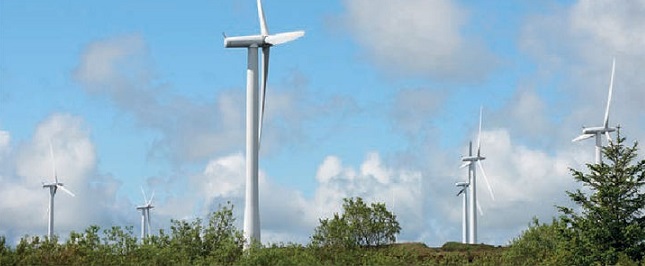
ONYX Insight has recently launched what it calls a “ground-breaking hardware solution” that predicts where and when costly pitch bearing failures occur in wind turbines.
This type of failure is a significant problem in the wind industry, the company notes. Pitch bearings connect the rotor hub to the blades, and experience high loading during the life of a turbine. There are many different modes of failure and the costs associated with fixing the faults are high, particularly if the turbine is offshore. In the most extreme cases a pitch bearing failure can lead to the catastrophic loss of a blade.
Based on its proven condition monitoring system, ecoCMS – already installed in thousands of turbines worldwide – ONYX Insight has developed ecoPITCH, a “revolutionary monitoring solution to identify pitch bearing faults before they occur.”
ecoPITCH uses innovative sensor hardware that is permanently installed in the hub and, through advanced data analytics, is able to detect early warning signs of impending pitch bearing failure, with the potential to save operators and owners significant capital in unscheduled maintenance.
The system uses “multiple data streams and advanced signal processing techniques, enabling operators to understand when faults are going to occur in this critical part of the turbine, which is notoriously difficult to monitor”, says ONYX Insight.
RES, ZX Lidars and KK Wind Solutions are also developing a hardware-plus-software retrofit concept aimed at upgrading wind farm performance. ReLACS (Retrofit Lidar Assisted wind farm Control System) is being trialled by TRIG (UK renewables-focused investment trust) at several of its onshore wind farms across the UK, starting with Altahullion in Northern Ireland.
The benefits of ReLACS are expected to include increased annual energy production, while also reducing turbine loads, which results in increased life expectancy for existing assets.
It consists of three distinct upgrades to each wind turbine:
Turbine controller retrofit – retrofit of state of the art controllers that enable access to modern algorithms that can optimise turbine performance, reduce loads and enable advanced control and monitoring systems to be added.
Wind farm control, wake steering backfit – yawing the turbine deflects wind flow and provides overall energy gain.
Lidar assisted turbine control (LAC) – turbine-mounted Lidar previews wind speeds and turbulence ahead of the turbine, providing optimised feedback that can ultimately reduce turbine loads.
Alex Woodward, commercial director at ZX Lidars, said: “The Lidar capability of ReLACS provided by ZX Lidars not only optimises feedback, which can reduce turbine loads, but it can also measure and validate and benchmark turbine performance. Lidars on every turbine will become commonplace.”

Kim Wichmann-Hansen, chief service officer at KK Wind Solutions, noted that the ReLACS retrofit package “gives access to state-of-the-art algorithms that deliver multiple benefits for operators of existing operating wind turbines – from rotor imbalance cancellation to optimum yaw control.”
Meanwhile, Ingeteam Wind Energy reports that its integrated all-in-one SCADA software is now installed across 20 GW of renewable energy projects worldwide, achieving improved asset monitoring and plant performance optimisation.
The company says in the past few years it has enjoyed increasingly strong demand for its INGESYS™ Smart SCADA suite across all renewable technology segments and recorded ongoing market share gains, with a “leading market position in Spain, Mexico, the United States and Australia.”
INGESYS™ Smart SCADA has been shown to deliver significant cost savings, enhanced security, and performance improvements for the integrated management of wind, solar and hydro assets, the company notes, and the platform, developed and fine-tuned over 30 years, “harnesses Big Data and IoT into a single product capable of solving the most complex operational challenges.”
Data-driven digital twin analytics is one of the most innovative tools to be integrated with the INGESYSTM Smart SCADA software, says Ingeteam. Created using both real-time and offline data collected from an extensive population in terms of location and technology through an integrated state-of-the-art historian tool suite, the models can be used to analyse performance and recommend corrective actions. “Powerful algorithms, dashboards and reporting capabilities allow asset managers to gain valuable insights to support decisions that have a large impact on overall performance. Machine learning algorithms continuously track the behaviour of key components and raise alerts in the event of non-conformance. Visual analytics enable technicians to clearly identify issues and respond swiftly.”
This article first appeared in Modern Power Systems magazine.






